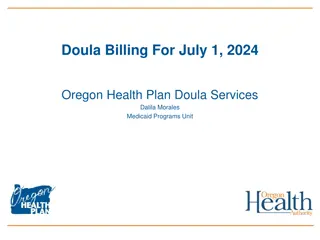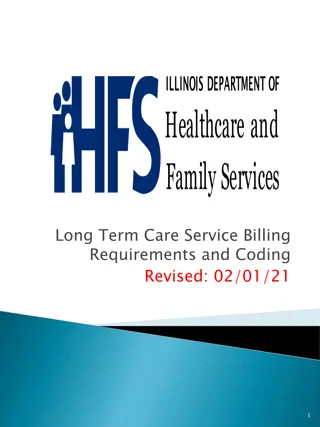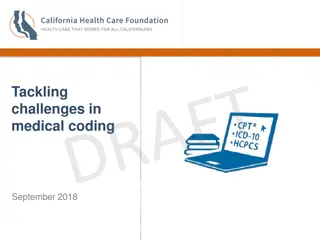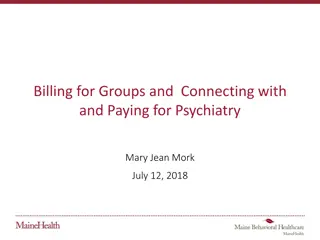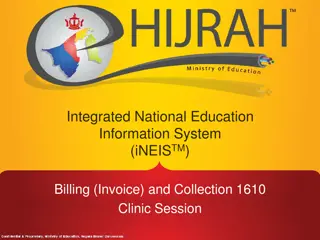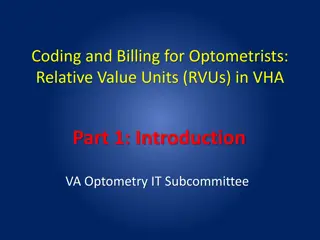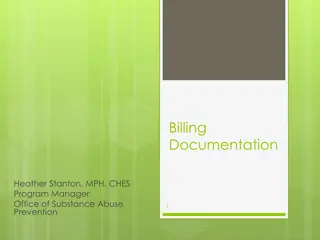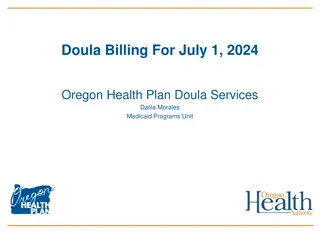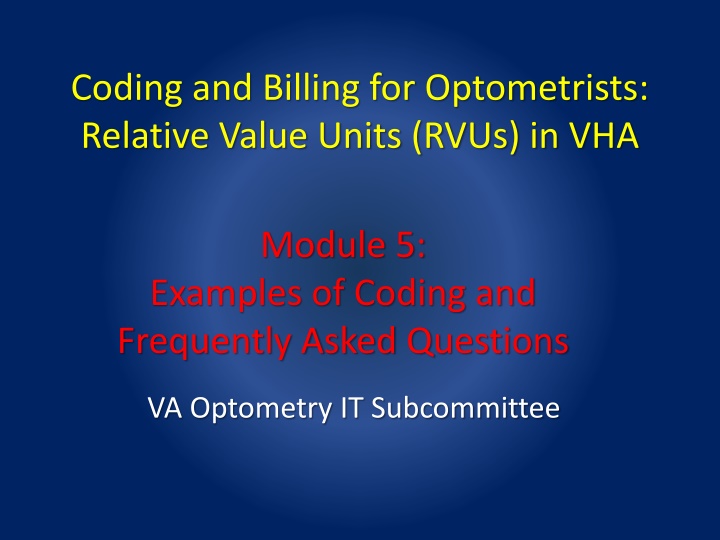
Coding and Billing for Optometrists within VA System
Optometry is integrated into the VA's RVU-based productivity methodology, utilizing DSS and CMS RVUs for proper resource allocation and cost accounting. RVUs play a crucial role in determining physician productivity and workload. Learn about the different types of RVUs used, data sources, and methods within the VA system.
Download Presentation

Please find below an Image/Link to download the presentation.
The content on the website is provided AS IS for your information and personal use only. It may not be sold, licensed, or shared on other websites without obtaining consent from the author. If you encounter any issues during the download, it is possible that the publisher has removed the file from their server.
You are allowed to download the files provided on this website for personal or commercial use, subject to the condition that they are used lawfully. All files are the property of their respective owners.
The content on the website is provided AS IS for your information and personal use only. It may not be sold, licensed, or shared on other websites without obtaining consent from the author.
E N D
Presentation Transcript
Coding and Billing for Optometrists: Relative Value Units (RVUs) in VHA Module 5: Examples of Coding and Frequently Asked Questions VA Optometry IT Subcommittee
Authors Ballinger, Rex OD- Baltimore, MD Cordes, Matthew OD- The Villages, FL Fuhr, Patti OD, PHD- Salisbury, NC Ihrig, Carolyn OD- Buffalo, NY Katzenberger, Ann OD- American Lake, WA Kawasaki, Brian OD- Las Vegas, NV Lazarou, Zoe OD- Baltimore, MD Ryan, Raymond OD- Eureka, CA Whitesell, Bethany- Fayetteville, AR Zimbalist, Richard OD- Columbia, MO
Background Optometry is now included in the Relative Value Unit (RVU) based VA productivity methodology: DSS (Decision Support System) RVU (do not confuse with clinical decision support systems) CMS RVU (Relative Value Unit) system (VA specific) These systems are a costs accounting and clinical activity relational database system. All patient services will need to be correctly and accurately documented to ensure proper resource allocation and utilization. Resources include labor, equipment, support and other expenses.
VA Relative Value Unit (RVUs) Quick Review There are two different types of RVUs used in VA 1. DSS RVUs used for budgeting, cost accounting,and workload all of which are time related -This is directly related to stop codes, clinic appointment set up, and RVU times assigned at the DSS level. 2. CMS RVUs which are used to capture workload times as well as exam complexity coding -This is related to CPT codes!! -This is the RVU measure in the Office of Productivity, Efficiency and Staffing (OPES).
Background All optometrists who have outpatient and inpatient PCE (Patient Care Encounter) encounter workload with CPT coding is used in calculating physician productivity within VA. However, this applies to paid clinicians only. Productivity is expressed in Relative Value Units (RVUs) per physician provider FTEE that is dedicated to clinical duties.
VA wRVU Data Sources and Methods Physicians, chiropractors, optometrists, podiatrists, and psychologists who are transmitting outpatient and inpatient PCE (Patient Care Encounter) encounter workload with CPT coding which is used in calculating physician productivity (wRVUs). The database contains workload for VA PAID physicians, In-House FEE physicians, residents not assigned to providers on encounter forms, without compensation physician providers (WOCs) and contract physician providers (DSS-RVUs).
Understand YOU CAN T BILL FOR WHAT YOU DO YOU CAN ONLY BILL FOR WHAT IS DOCUMENTED YOU CAN T GET PROPER CREDIT FOR YOUR WORKLOAD UNLESS YOU CODE CORRECTLY and are MAPPED correctly YOUR CODING MUST BE TIMELY!! Your DSS workload is captured monthly- your encounters must be in by the monthly deadline or your work is NOT captured and never will be!!!
Remember Notes should include for I&R (interpretation and reporting): What you asked What you did Why you did it What you found and what you plan to do about it Documentation as above supports your coding!
CPT Codes This is the key to developing the correct RVU data. Be sure you carefully document all your CPT codes. We covered all of the pertinent CPT code information for you in the CPT training module. These codes must be supported by your diagnosis codes which we will cover in this module.
Coding Review ICD-9 Code review
ICD-9 Coding The following slides highlight the important issues regarding ICD-9 Coding. There are many more specific issues that are beyond the scope of this module. Please refer to the latest edition of the ICD-9- CM Official Guidelines for Coding and Reporting.
ICD-9 Coding For accurate reporting of ICD-9-CM diagnosis codes, the documentation should describe the patient's condition, using terminology which includes specific diagnoses as well as symptoms, problems, or reasons for the encounter. There are ICD-9-CM codes to describe all of these situations.
ICD-9 Coding Codes that describe symptoms and signs, as opposed to diagnoses, are acceptable for reporting purposes when an established diagnosis has not been diagnosed (confirmed) by the physician.
ICD-9 Coding ICD-9-CM provides codes to deal with encounters for circumstances other than a disease or injury.
Important! An ICD-9 code is invalid if it has not been coded to the full number of digits required for that code.
Correct ICD-9 Coding List first the ICD-9-CM code for the diagnosis, condition, problem, or other reason for encounter/visit shown in the medical record to be chiefly responsible for the services provided. List additional codes that describe any co- existing conditions.
Correct ICD-9 Coding Do not code diagnoses documented as "probable", "suspected," "questionable," "rule out," or working diagnosis. Rather, code the condition(s) to the highest degree of certainty for that encounter/visit, such as symptoms, signs, abnormal test results, or other reason for the visit.
Chronic Diseases Chronic diseases treated on an ongoing basis may be coded and reported as many times as the patient receives treatment and care for the condition(s).
Correct Coding Code all documented conditions that co-exist at the time of the encounter/visit, and require or affect patient care treatment or management. Do not code conditions that were previously treated and no longer exist. However, history codes (V10- V19) may be used as secondary codes if the historical condition or family history has an impact on current care or influences treatment.
Correct Coding Again, for patients receiving diagnostic services only during an encounter/visit, sequence first the diagnosis, condition, problem, or other reason for encounter/visit shown in the medical record to be chiefly responsible for the outpatient services provided during the encounter/visit. Codes for other diagnoses (e.g., chronic conditions) may be sequenced as additional diagnoses.
Correct Coding For patients receiving therapeutic services only during an encounter/visit, sequence first the diagnosis, condition, problem, or other reason for encounter/visit shown in the medical record to be chiefly responsible for the outpatient services provided during the encounter/visit.
Combination Code A combination code is a single code used to classify: Two diagnoses, or A diagnosis with an associated secondary process (manifestation), or A diagnosis with an associated complication.
Combination Codes Are identified by referring to sub-term entries in the Alphabetic Index and by reading the inclusion and exclusion notes in the Tabular List. Assign only the combination code when that code fully identifies the diagnostic conditions involved or when the Alphabetic Index so directs. Multiple coding should not be used when the classification provides a combination code that clearly identifies all of the elements documented in the diagnosis.
Correct Coding When the combination code lacks necessary specificity in describing the manifestation or complication, an additional code should be used as a secondary code.
Example Combination Code 250.00 diabetes with 362.04- mild non- proliferative diabetic retinopathy More than one code from category 250 may be used with as many manifestation codes as are needed to fully describe the patient s complete diabetic condition.
Combination Coding Certain conditions have both an underlying etiology and multiple body system manifestations due to the underlying etiology. For such conditions, the ICD-9-CM has a coding convention that requires the underlying condition be sequenced first followed by the manifestation.
Other Descriptive Abbreviations NEC - Not Elsewhere Classifiable : This abbreviation in the Alphabetical Index represents other specified when a specific code is not available for a condition; the Alphabetical Index directs the coder to the other specified code in the Tabular List. NOS - Not Otherwise Specified : This abbreviation is the equivalent of unspecified.
Includes and Excludes Notes and Inclusion Terms Includes Note: This note appears immediately under a three-digit code title to further define, or give examples of, the content of the category. Excludes Note: An excludes note under a code indicates that the terms excluded from the code are to be coded elsewhere. Inclusion Terms: The list of terms is included under certain four and five digit codes.
Other and Unspecified Codes Other Codes: These codes are for use when the information in the medical record provides detail for which a specific code does not exist. Unspecified Codes: These codes are for use when the information in the medical record is insufficient to assign a more specific code.
Etiology/Manifestation Convention Certain conditions have both an underlying etiology and multiple body system manifestations due to the underlying etiology. For such conditions, the ICD-9-CM has a coding convention that requires the underlying condition be sequenced first followed by the manifestation.
Etiology/Manifestation Convention Wherever such a combination exists, there is a use additional code note for the etiology code, and a code first note for the manifestation code. These instructional notes indicate the proper sequencing order of the codes, with etiology followed by manifestation.
Etiology/Manifestation Convention The most commonly used etiology/manifestation combinations are the codes for Diabetes mellitus, category 250. For each code under category 250 there is a use additional code note for the manifestation that is specific for that particular diabetic manifestation. Should a patient have more than one manifestation of diabetes, more than one code from category 250 may be used with as many manifestation codes as are needed to fully describe the patient s complete diabetic condition.
Signs and Symptoms Codes that describe signs and symptoms, as opposed to diagnoses, are acceptable for reporting purposes when a related definitive diagnosis has not been established (confirmed) by the provider.
Conditions That Are An Integral Part Of A Disease Process Signs and symptoms that are associated routinely with a disease process should not be assigned as additional codes, unless otherwise instructed by the classification.
Conditions That Are Not An Integral Part Of A Disease Process Additional signs and symptoms that may not be associated routinely with a disease process should be coded when present.
Acute and Chronic Conditions If the same condition is described as both acute (sub-acute) and chronic, and separate subentries exist in the Alphabetic Index at the same indentation level, code both and sequence the acute (sub-acute) code first.
Reporting Same Diagnosis Code More Than Once Each unique ICD-9-CM diagnosis code may be reported only once for an encounter. This applies to bilateral conditions or two different conditions classified to the same ICD-9-CM diagnosis code.
Eyeglasses Fitting Minimal documentation requirements for optometrist or technician for the use of codes 92340-92342 include: measurements of anatomical facial characteristics, records the laboratory specifications, and performs the final adjustment of the spectacles to the visual axes and anatomical topography. If the final adjustment is performed on a later date, use V53.1, fitting & adjustment of other device: spectacles & contact lenses. The supporting documentation must be contained within the medical record.
Ophthalmic Technician When the technician provides services for a patient in conjunction with an optometrist or ophthalmologist: The technician is reported in ADM as an additional provider using the designation paraprofessional. Additional codes for any procedures the technician performs (e.g., spectacle ordering, visual field testing) are to be reported.
Technicians When a technician provides services at a separate encounter, the correct procedures (e.g., 99173, visual acuity screening) are entered in the CPT/HCPCS field . Example: Patient seen by technician for vision exam portion of routine physical: V70.5_2 Routine annual physical 99173 Screening test of visual acuity If a technician performs one of these procedures (99172 or 99173) at a separate encounter no E/M level is assigned and one of these codes is assigned.
Frequently Asked Coding Questions The following provides common questions and answers regarding coding and billing.
Question 1 Question 1: Shouldn t we get RVU credit if we enter the interpretation into the patient chart as a historical visit on the day of the Visual Field testing? Answer 1: The professional interpretation CPT code 92083 with modifier code 26 will suffice for RVU credit if your note has sufficient documentation to support it.
Question 2 Can we bill Medicare for both an intermediate established patient exam and a gonioscopy exam? Also, is gonioscopy a bilateral procedure?
Answer 2 Gonioscopy is inherently bilateral - the Physician Fee Schedule has valued the procedure based on the work involved for both eyes. If you perform gonioscopy on only one eye, append modifier -52 (Reduced services) to 92020.
Question 3 I know in the actual coding scheme of things (i.e. private sector), procedure codes are linked to diagnosis codes, but since our encounter templates don t require that, most of the VA optometrists here are unaware of these connections. Here s where this may be an issue. We are often coding the refraction procedure, but may not have the refractive code in the diagnosis list (not even as a secondary). Do we need that code in there to get credit for the refractive procedure?
Guidance For outpatient claims, providers report the full diagnosis code for the diagnosis shown to be chiefly responsible for the outpatient services. If a patient is seen on an outpatient basis for an evaluation of a symptom for which a definitive diagnosis is not made, the symptom is reported. If, during the course of the outpatient evaluation and treatment, a definitive diagnosis is made, the definitive diagnosis is reported.
Answer 3 If you report a procedure code, your note details must support this and you should also code for the diagnosis to support the procedure. They must be linked. Just because you are not reminded in CPRS to do this, you should code all diagnosis and procedures to get full credit, otherwise the billing and RVU capture will be incomplete.
Question 4 We ve having some in-depth discussions regarding coding (99000 codes) here and the question came up if there are templates/ documents in use that we might export for use at our eye clinic (For example, forms to use in ROS, examination templates set up for E&M coding, etc.).
Answer 4 Templates are being developed at this time and are not yet widely available. When available, they will initially have minimal capabilities.
Question 5 Do you know if anyone has ever put in a CPRS ticket to fix the problem on the ENCOUNTER FORM with the diagnoses JUMPING to another line when clicking a diagnosis? This certainly results in errors if the user doesn t notice that it jumped. It seems to have been like this for years and I m surprised it hasn t been fixed. Maybe the CPRS software engineers don t know?

